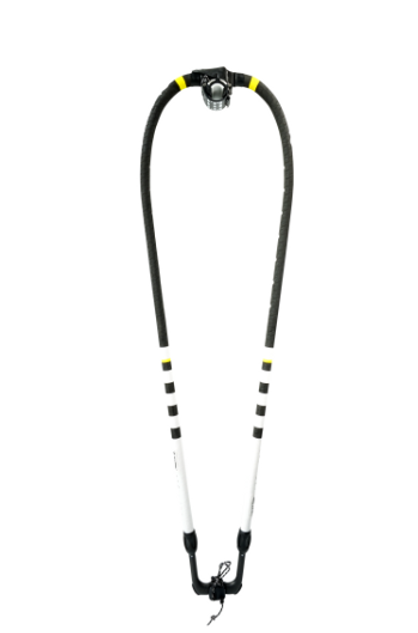The first target from the Point-7 Black Team when developing a boom is the curve. This is not about having a curve from the new generation as many might call it. It’s about having a curve which allows your front and back arm to sit in a natural ergonomic position while sailing, automatically positioning the sail at the right angle for the wind to enter and exit the sail. This position varies with the wind strength and windsurfing discipline, so each boom size needs to be developed accordingly.

Black Team Curves.
The needs of a wave boom’s curve is very different from the curve for a slalom boom, just like a slalom boom for strong wind is very different from a boom for light wind slalom – one needs to offer control and the other power. Developing the right curve brings comfort and, respectively, performance.

Back End width.
We have developed the correct tail width to suit each boom size and its uses. The width of the back end of a boom is very important – the wider, the more power; the narrower, the more control. We have studied each size to fit best the sail sizes it’s designed for.

Smart Balanced design.
Diameter is another important factor as it does bring comfort to the forearms and saves wasting energy whilst out on the water. At Point-7 we have developed our boom using the Octatube – a carbon tube shape with 8 sides, designed to ergonomically fit the natural shape of the hand when gripping. We vary the diameter used according to the discipline; 25mm for the wave boom, 26mm on the free wave\slalom 160 and 170-slalom boom, and 29mm on the two larger sizes of the slalom boom.

Reflex.
The stiffness of a carbon boom is also very important, the right mix between reflex and comfort needs to be found. Just as masts have different IMCS, our booms are also being developed to offer the right stiffness to allow comfort in smaller sails sizes, and more reflex in bigger sail sizes.

Weight.
You can have the lightest and stiffest boom available, but if these main features are wrong then the boom will feel heavy and uncomfortable. The weight needs to be front oriented on the boom, leaving the tail end of the boom light. A heavy tail-end will make a light boom, in general, feel heavier than it really is. This is why we use a taper through to the tail section, the wider diameter allows to have thinner and lighter carbon walls where there is no need for us to grip, but also more stiffness where it is most important.

AUTOMATIC OUTHAUL SYSTEM
Introducing the new quick adjustment lock for the outhaul system. No longer need to undo knots to fix your adjustable outhaul system. Keep the loop on the backend, make it go around the eyelet of the sail, and directly around the fixed round wheel of the boom. Save time while rigging. Available on the boom sizes: 170 | 190 | 220.
For the other smaller boom sizes, 140 | 150 | 160, a very similar concept is used, where a loop can easily be attached to a hook after going through the sail clew, and therefore no need to undo knots or waste time getting the ropes through boom back end holes.


Boom Grip is lightly sanded, anti-slip pro grip: Less strength needed from you for a firm grip on the boom. Easy positioning marks for the harness lines.
Tail end: To be less bulky in maneuvers and high winds, the tail end is made to fit inside the boom body in the smaller sized booms: wave 140, 150, the free wave\slalom 160 and slalom 170. To further reduce the weight and increase the stiffness of the bigger 190 and 210 booms, the diameter of the tail pieces is increased and fit outside the boom body.
Tail end pulley system:the wave sizes have the quick loop system, while the slalom sizes are having pulleys to host the adjustable outhaul system or simple threading to fix the clew tension.
Boom double pin clips for a stiffer connection between boom body and tail end, with 2cm adjustments. Different sizes used to best suit the boom size.












